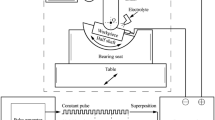Abstract
Electrolytic in-process dressing (ELID) is a grinding technique used to generate high-quality surfaces on hard and brittle material. Oxide layer formed on grinding wheel during ELID grinding heavily influences the surface roughness of the workpiece. To study the microscopic structure of the oxide layer and model the thickness of it, we conducted a previously reported study on metallic-bonded prism samples with major adjustments and implementations. The parameter studied are voltage, electrode-grinding wheel gap, and coolant flow rate. Scanning electron microscopy (SEM) images of cross-section of the oxidation sites were captured and compared and oxide layer thickness was accurately measured. All three parameters are found to significantly affect the formation of the oxide layer.
Similar content being viewed by others
References
Ohmori H, Nakagawa T (1990) Mirror surface grinding of silicon wafers with electrolytic in-process dressing. CIRP Ann 39(1):329–332. https://doi.org/10.1016/S0007-8506(07)61065-8
Ohmori H, Nakagawa T (1995) Analysis of mirror surface generation of hard and brittle materials by ELID (electronic in-process dressing) grinding with superfine grain metallic bond wheels. CIRP Ann 44(1):287–290. https://doi.org/10.1016/S0007-8506(07)62327-0
Ohmori H, Marinescu ID, Katahira K (2011) Electrolytic in-process dressing (ELID). Taylor & Francis Group, LLC, Boca Raton, FL
Bafakeeh OT, Khoshaim AB, Marinescu ID (2016) ELID fine grinding of sapphire rollers with emphasis on roughness and material removal rate. Procedia Manuf 5:1249–1264. https://doi.org/10.1016/j.promfg.2016.08.098
Ohmori H, Nakagawa T (1997) Utilization of nonlinear conditions in precision grinding with ELID (electrolytic in-process dressing) for fabrication of hard material components. CIRP Ann 46(1):261–264. https://doi.org/10.1016/S0007-8506(07)60821-X
Lim HS, Fathima K, Senthil Kumar A, Rahman M (2002) A fundamental study on the mechanism of electrolytic in-process dressing (ELID) grinding. Int J Mach Tools Manuf 42(8):935–943. https://doi.org/10.1016/S0890-6955(02)00023-8
Prabhu S, Vinayagam BK (2013) Analysis of surface characteristics by electrolytic in-process dressing (ELID) technique for grinding process using single wall carbon nano tube-based nanofluids. Arab J Sci Eng 38(5):1169–1178. https://doi.org/10.1007/s13369-012-0355-6
Lee E, Kim J (1997) A study on the analysis of grinding mechanism and development of dressing system by using optimum in-process electrolytic dressing. Int J Mach Tools Manuf 37(12):1673–1689. https://doi.org/10.1016/S0890-6955(97)00030-8
Saleh T, Bishwas I, Rahman M (2010) Efficient dressing of the wheel in ELID grinding by controllable voltage with force feedback. Int J Adv Manuf Technol 46(1–4):123–130. https://doi.org/10.1007/s00170-009-2076-x
Yang L, Ren C, Jin X (2010) Experimental study of ELID grinding based on the active control of oxide layer. J Mater Process Technol 210(13):1748–1753. https://doi.org/10.1016/j.jmatprotec.2010.06.005
Saleh T, Rahman M (2014) Electrolytic in-process dressing grinding for nano-surface generation’, in Comprehensive Materials Processing 11:483–522. doi: https://doi.org/10.1016/B978-0-08-043848-1.00097-3
Wang Z, Ren C, Chen G, Zhang L, Deng X (2018) A comparative study on state of oxide layer in ELID grinding with tool-cathode and workpiece-cathode. Int J Adv Manuf Technol 94(1–4):1299–1307. https://doi.org/10.1007/s00170-017-0931-8
Klocke F, Klink A, Henerichs M (2009) ELID dressing behaviour of fine grained bronze bonded diamond grinding wheels. Int J Abras Technol 2(4):358–367. https://doi.org/10.1504/IJAT.2009.029094
Pavel R, Pavel M, Marinescu I (2004) Investigation of pre-dressing time for ELID grinding technique. J Mater Process Technol 149(1–3):591–596. https://doi.org/10.1016/j.jmatprotec.2004.02.026
Chen H, Li JCM (2000) Anodic metal matrix removal rate in electrolytic in-process dressing I: two-dimensional modeling. J Appl Phys 87(6):3151–3158. https://doi.org/10.1063/1.372313
Biswas I, Senthil Kumar A, Rahman M (2010) Experimental study of wheel wear in electrolytic in-process dressing and grinding. Int J Adv Manuf Technol 50(9–12):931–940. https://doi.org/10.1007/s00170-010-2589-3.
Funding
This research was funded by The Precision Micro Machining Center and The Instrumentation Center at the University of Toledo.
Author information
Authors and Affiliations
Corresponding author
Additional information
Publisher’s note
Springer Nature remains neutral with regard to jurisdictional claims in published maps and institutional affiliations.
Rights and permissions
About this article
Cite this article
Alqahtani, B., Zhang, M., Marinescu, I. et al. Microscopic characterization and modeling of oxide layer for electrolytic in-process dressing (ELID) grinding with focus on voltage, electrode-wheel gap, and coolant flow. Int J Adv Manuf Technol 105, 4853–4862 (2019). https://doi.org/10.1007/s00170-019-03435-5
Received:
Accepted:
Published:
Issue Date:
DOI: https://doi.org/10.1007/s00170-019-03435-5




